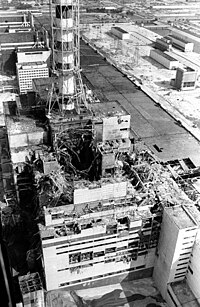
Back Tsjernobil-kernramp Afrikaans Katastrophe von Tschernobyl ALS كارثة تشيرنوبل Arabic كارثه تشرنوبل ARZ চাৰ্ন'বিল বিপৰ্যয় Assamese Accidente de Chernóbil AST Çernobıl faciəsi Azerbaijani چرنوبیل فاجیعهسی AZB Чарнобыльская катастрофа Byelorussian Чарнобыльская катастрофа BE-X-OLD
 Reactor 4 several months after the disaster. Reactor 3 can be seen behind the ventilation stack. | |
| Date | April 26, 1986 |
|---|---|
| Time | 01:23 MSD (UTC+04:00) |
| Duration | 1986-Present |
| Location | Chernobyl Nuclear Power Plant |
| Type | Nuclear Accident |
| Cause | Reactor design and operator error |
| Outcome | INES Level 7 |
| Deaths | 28 from Radiation Posioning, 2 killed in disaster, 15 from terminal thyroid cancer |
| Missing | 1 |
| Nuclear energy |
|---|
 |



The Chernobyl disaster[1] was a nuclear disaster. It happened on April 26, 1986 at the Chernobyl nuclear power plant near the town of Pripyat, Ukraine. At that time, Ukraine was part of the Soviet Union. The station is 110 kilometres north of the nation's capital, Kyiv.
The event was one of the worst accidents in the history of nuclear power. It was rated level 7, the most severe level, on the International Nuclear Event Scale. The only other accident with a level 7 rating is Fukushima. The RBMK reactors that were used at the plant had no containment building to keep the radiation in. Radioactive fallout drifted over parts of the western Soviet Union, Eastern Europe, Scandinavia, the United Kingdom, and the eastern United States. Large areas of Ukraine, Belarus, and Russia were badly contaminated. About 60% of the radioactive fallout landed in Belarus.[2][3] About 360,000 people needed to be moved to other places where they could live after the accident. Many people suffered from acute radiation poisoning and long-term illnesses such as thyroid cancer.[4][5]
- ↑ Ukrainian: Чорнобильська катастрофа
- ↑ ICRIN Project (2011). International Chernobyl Portal chernobyl.info.
- ↑ Environmental consequences of the Chernobyl accident and their remediation: Twenty years of experience. Report of the Chernobyl Forum Expert Group 'Environment' (PDF). Vienna: International Atomic Energy Agency. 2006. p. 180. ISBN 92-0-114705-8. Retrieved 13 March 2011.
- ↑ "Table 2.2 Number of people affected by the Chernobyl accident (to December 2000)" (PDF). The Human Consequences of the Chernobyl Nuclear Accident. UNDP and UNICEF. 22 January 2002. p. 32. Archived from the original (PDF) on 1 February 2017. Retrieved 17 September 2010.
- ↑ "Table 5.3: Evacuated and resettled people" (PDF). The Human Consequences of the Chernobyl Nuclear Accident. UNDP and UNICEF. 22 January 2002. p. 66. Archived from the original (PDF) on 1 February 2017. Retrieved 17 September 2010.